Marrying Vega and Zen: The AMD Ryzen 5 2400G Review
by Ian Cutress on February 12, 2018 9:00 AM ESTiGPU Gaming Performance, Continued
Rise of the Tomb Raider
One of the most comprehensive games in the gaming benchmark suite is Rise of the Tomb Raider (RoTR), developed by Crystal Dynamics, and the sequel to the popular Tomb Raider which was loved for its automated benchmark mode. But don’t let that fool you: the benchmark mode in RoTR is very much different this time around.
Visually, the previous Tomb Raider pushed realism to the limits with features such as TressFX, and the new RoTR goes one stage further when it comes to graphics fidelity. This leads to an interesting set of requirements in hardware: some sections of the game are typically GPU limited, whereas others with a lot of long-range physics can be CPU limited, depending on how the driver can translate the DirectX 12 workload.

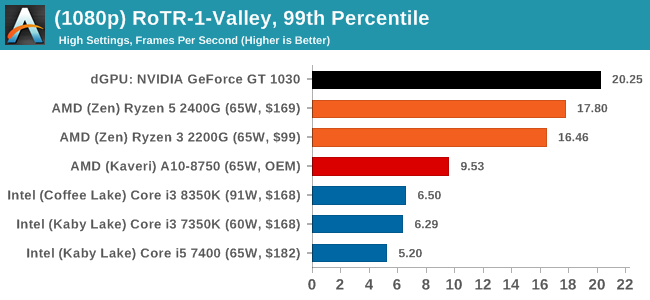
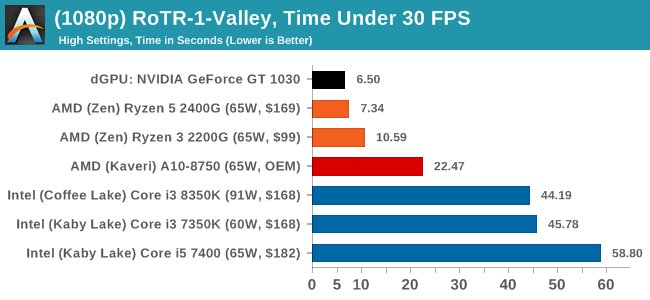
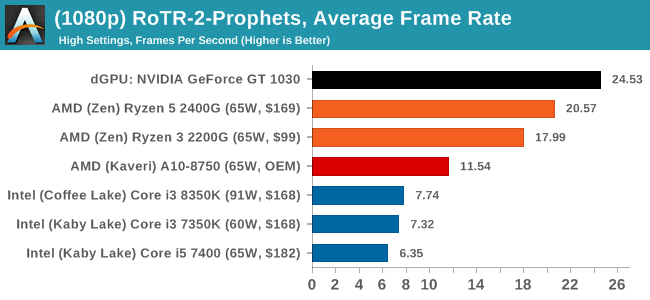
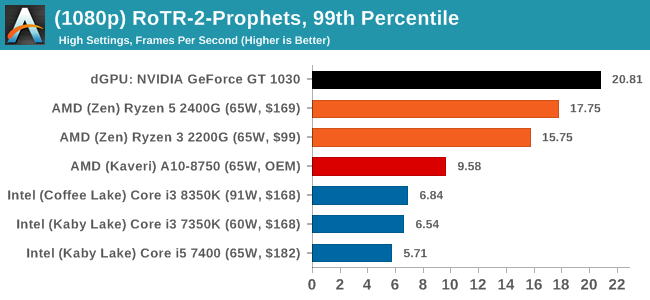
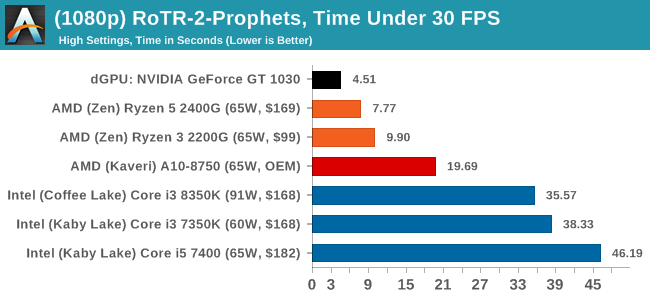

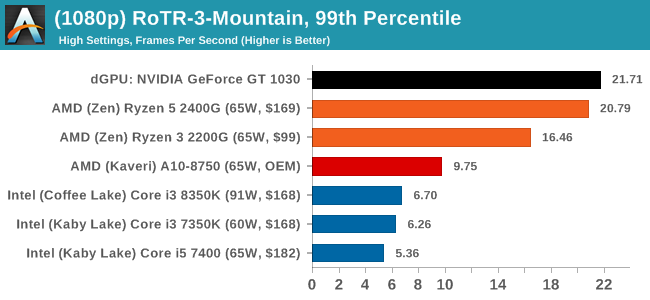
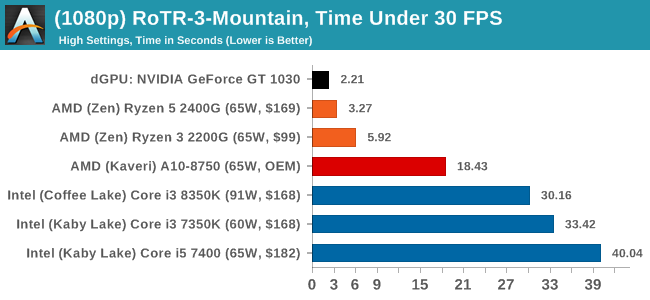
The GT 1030 sweeps the top spot against AMD here, though only by small margins most of the time. The AMD APUs still offer a commanding 2-3x performance jump over Intel's product line, and even more when price is factored into the equation.
Rocket League
Hilariously simple and embodying the elements of pick-up-and-play, Rocket League allows users to jump into a game with other people (or bots) to play football with cars with zero rules. The title is built on Unreal Engine 3, which is somewhat old at this point, but it allows users to run the game on super-low-end systems while still taxing the big ones. Since the release in 2015, it has sold over 5 million copies and seems to be a fixture at LANs and game shows. Users who train get very serious, playing in teams and leagues with very few settings to configure, and everyone is on the same level. Rocket League is quickly becoming one of the favored titles for e-sports tournaments, especially when e-sports contests can be viewed directly from the game interface.
With Rocket League, there is no benchmark mode, so we have to perform a series of automated actions, similar to a racing game having a fixed number of laps. We take the following approach: Using Fraps to record the time taken to show each frame (and the overall frame rates), we use an automation tool to set up a consistent 4v4 bot match on easy, with the system applying a series of inputs throughout the run, such as switching camera angles and driving around.
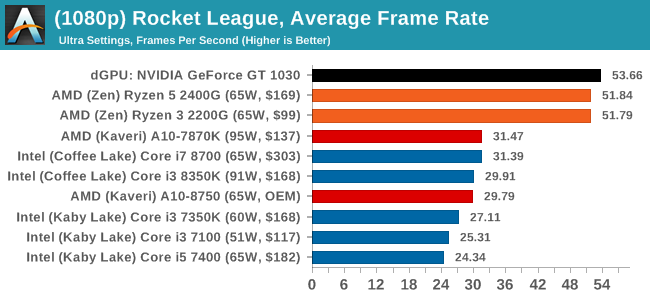
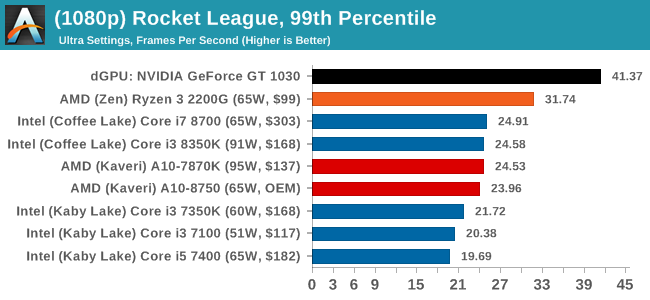

As the more eSports oriented title in our testing, Rocket League is less graphically intense than the others, and by being built on DX9, also tends to benefit from a good single thread performance. The GT 1030 wins again here, most noticably in the 99th percentile numbers, but the AMD chips are hitting 30 FPS in that percentile graph, whereas in the last generation they were getting 30 FPS average. That is a reasonable step up in performance, aided both to the graphics and the high-performance x86 cores. It will be interesting to see how the memory speed changes the results here.










177 Comments
View All Comments
SSNSeawolf - Monday, February 12, 2018 - link
Wonderful, that's understandable. Always appreciate the time you take to slog through the comments, Ian.HStewart - Monday, February 12, 2018 - link
It might be me - unless you are really serious gamer and need high end performance, I see no reason to use a desktop CPU and GPU in todays world.Holliday75 - Monday, February 12, 2018 - link
That appears to be the case. This CPU would be my go to option for any family member wanting a PC these days. The flexibility it offers is remarkable.B3an - Monday, February 12, 2018 - link
Mistake on the Blender benchmark. The latest version is 2.79 but you've put "2.78". Being as you also have a nightly build you might even have 2.8 if you've got it from the 2.8 nightly branch. Either way you will have at least 2.79.milkod2001 - Monday, February 12, 2018 - link
Looks like decent but still 720 gaming at the best. How far away are we from 40-50fps 1080p gaming from APU?richardginn - Monday, February 12, 2018 - link
Depending on the game you are going to play you will need low settings to get 40-50fps 1080p gaming from this APU,.Yaldabaoth - Monday, February 12, 2018 - link
Great article. However, because I am a pervert, I would LOVE to see some heterogeneous GPU action going on. "Does an AMD 2400G and a nVidia 1050 make a baby that is like a 1050 TI? What about if it mated with a Vega 56 or 580?" Know what I mean? [Nudge-nudge] Know what I mean?Threska - Wednesday, February 14, 2018 - link
Heterogeneous would be an APU, not crossfire. Far as AMD's plans with HSA who knows? They're not doing much talk about it since Zen came out. Maybe they don't need it now that their single thread performance is competitive?Pork@III - Monday, February 12, 2018 - link
Core i7-8809G will smash easily Ryzen 5 2400Ganactoraaron - Monday, February 12, 2018 - link
If cost is no concern, then yes.